Recent advancements in cancer research have illuminated new pathways for potential treatment options, with a notable focus on the role of intracellular kinases in tumor progression. Among these, breast tumor kinase (Brk) has garnered attention due to its involvement in oncogenic signaling pathways that promote cancer cell proliferation, migration, and survival. Brk functions through the phosphorylation of key proteins, including focal adhesion kinase (FAK) and signal transducer and activator of transcription 3 (STAT3), thereby driving various malignancies forward, particularly those related to prostate cancer.
In a groundbreaking study, researchers have isolated a compound known as Demethylmycemycin A (DA) from a marine-derived source, specifically the sponge-associated bacterium Dactylosporangium sp. OK1079. This compound belongs to the class of dibenzoxazepinones, a group that has not previously been explored for its biological activity in the context of cancer therapeutics. The novelty of this discovery lies not only in its marine origin but also in its potential to disrupt established kinases involved in cancer progression, particularly Brk.
Previous investigations have revealed that marine-derived compounds hold invaluable promise due to their unique structural integrity and potent bioactivity. One noteworthy example is the marine triterpene sipholenol A, which has been shown to interact effectively with Brk through its perhydrobenzoxepine system. Given this structural characteristic shared between DA and sipholenol A, researchers were motivated to conduct molecular docking simulations to predict DA’s binding efficacy to Brk. The hypothesis was that DA’s bioisosteric resemblance to sipholenol A could yield similar or superior Brk inhibitory effects.
The antiproliferative effects of DA were evaluated against a panel of prostate cancer (PC) cell lines, which included LNCaP, PC3, 22Rv1, and the androgen-independent DU145 cells. Among these, LNCaP cells demonstrated the highest sensitivity to DA treatment, yielding an impressive IC50 value of 7.6 μM. In comparison, PC3 cells exhibited a slightly diminished sensitivity with an IC50 of 9.8 μM. These findings are highly significant as they underscore DA’s potential as a targeted therapy in the treatment of hormone-sensitive prostate cancer.
Furthermore, cellular assays revealed that DA not only inhibited the proliferation of cancer cells but also significantly curtailed their migratory capabilities and clonogenic potential. This is particularly noteworthy in the context of cancer metastasis, where the ability of tumor cells to migrate and form new colonies is crucial for disease progression. This dual action of proliferation suppression and migration inhibition positions DA as a multifaceted agent in combatting prostate cancer.
In examining the underlying mechanisms of action, Western blot analyses were employed to assess the expression levels of key oncogenic proteins after DA treatment. Results indicated that DA effectively reduced the activation states of Brk, FAK, and STAT3 in a dose-dependent manner across both LNCaP and PC3 cell lines. This finding is particularly critical, as the deactivation of these pathways can lead to a decline in tumorigenic processes and suggest a therapeutic role for DA in prostate cancer management.
Interestingly, while DA treatment induced a reduction in the levels of activated FAK and STAT3, it did not significantly alter the total expression of Brk, suggesting that DA may specifically target the activation rather than the overall abundance of this kinase. However, a notable suppression of total STAT3 was observed exclusively in LNCaP cells, illuminating the possibility of cell line-specific responses to DA treatment. This specificity warrants further investigation and emphasizes the complexity of cancer biology, where different cell lines may exhibit unique vulnerabilities to therapeutic agents.
Furthermore, the ability of DA to decrease activated FAK is especially pertinent, as this protein is known to play a vital role in cell adhesion and migration. By impairing FAK activation, DA may disrupt multiple signaling pathways crucial for tumor cell invasion, thus providing a strategic advantage in therapy. As the scientific community continues to explore the intricacies of these interactions, DA has emerged as a promising candidate for further development in targeted cancer treatment strategies.
The implications of these findings extend beyond the immediate scope of DA as a singular therapeutic agent. The insights gained from the molecular interactions and biological effects observed in this study herald the potential for new exploration into other marine-derived compounds that may be engineered or modified for enhanced activity against various cancers. Given the alarming rates of prostate cancer incidence and mortality, novel interventions like DA could significantly alter the therapeutic landscape for patients.
Moreover, as scientists continue to unravel the molecular underpinnings of how DA interacts with the Brk-FAK-STAT3 axis, there is hope for the development of new modalities of treatment that not only inhibit tumor growth but also prevent the spread of cancer cells within the body. As the search for effective, non-toxic cancer therapies becomes ever more urgent, the rise of DA underscores the viability of nature-derived treatments finding a place in modern medicine.
In conclusion, the research surrounding Demethylmycemycin A highlights a transformative moment in the quest for effective cancer therapies. As scientists gain new insights into its mechanisms of action and therapeutic potential, DA stands poised to become a cornerstone in the future management of prostate cancer, particularly in patients exhibiting Brk expression. The ongoing research into its pharmacological properties and the extensive preclinical evidence accumulated thus far will be crucial in determining its success in clinical applications, potentially ushering in a new era of targeted cancer treatment.
The journey from laboratory exploration to clinical utilization is fraught with challenges, yet the promise shown by DA is both exciting and inspiring. As researchers remain committed to discovering new ways to combat cancer, DA may one day become a valuable weapon in the fight against one of the most prevalent forms of cancer affecting men today.
Subject of Research: Demethylmycemycin A for prostate cancer therapy
Article Title: Demethylmycemycin A, a dibenzoxazepinone from the marine-derived Dactylosporangium sp. OK1079, with prostate cancer suppressive effects via targeting BRK-FAK-STAT3 axis.
Article References:
Elsbaey, M., Tarun, M.T.I., Alnajjar, R. et al. Demethylmycemycin A, a dibenzoxazepinone from the marine-derived Dactylosporangium sp. OK1079, with prostate cancer suppressive effects via targeting BRK-FAK-STAT3 axis. J Antibiot (2025). https://doi.org/10.1038/s41429-025-00871-2
Image Credits: AI Generated
DOI: 07 November 2025
Keywords: Demethylmycemycin A, prostate cancer, BRK-FAK-STAT3 axis, marine-derived compounds, antiproliferative effects, oncogenic signaling.
Tags: bioactive marine compoundsbreast tumor kinase targetingDemethylmycemycin A compounddibenzoxazepinones in cancer researchdisrupting cancer progression mechanismsintracellular kinases in cancermarine sponge-associated bacteriamarine-derived cancer therapeuticsnovel cancer treatment strategiesoncogenic signaling pathways in tumorsphosphorylation of cancer-related proteinsprostate cancer treatment pathways





